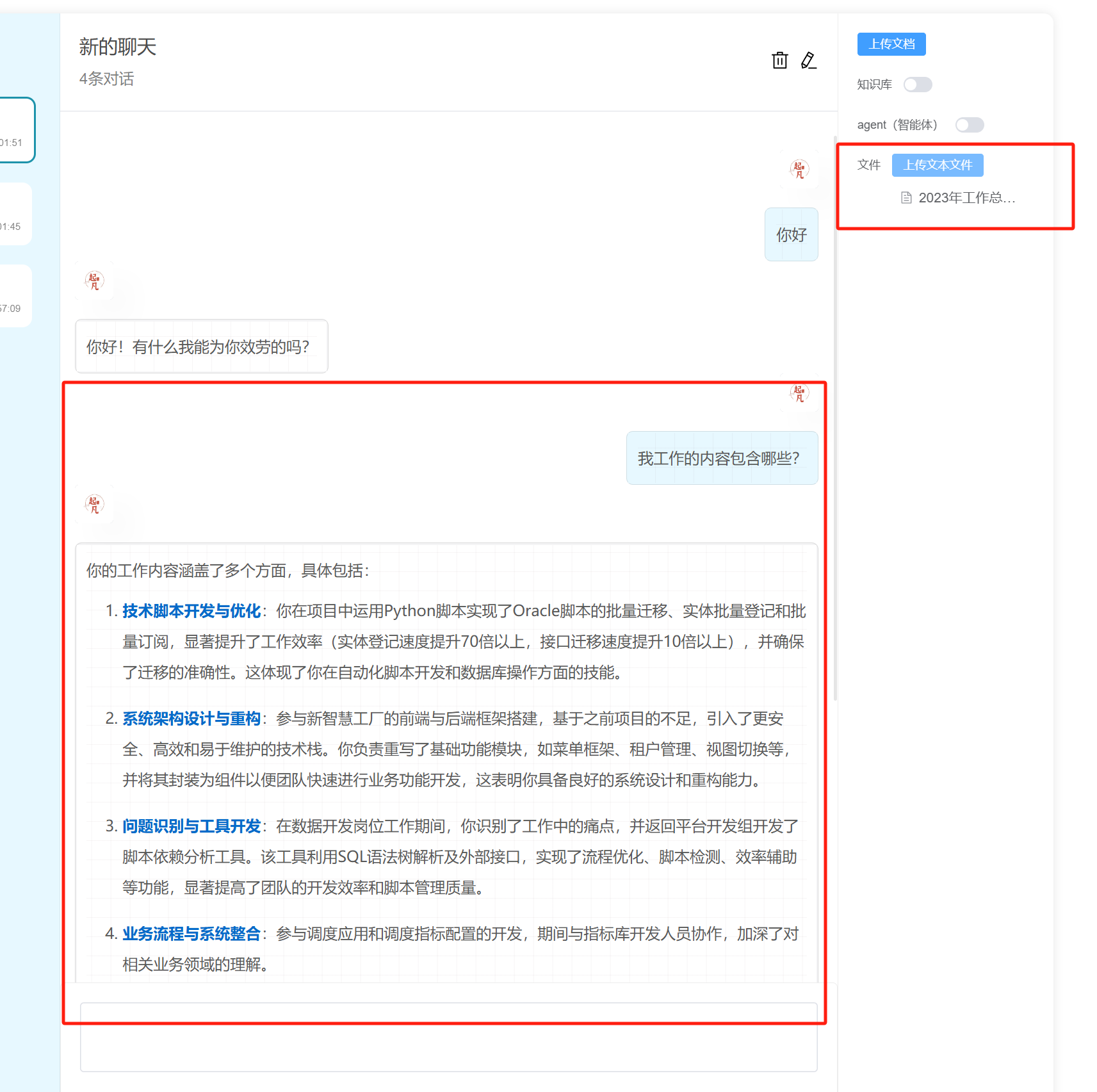文件问答
2025/6/21大约 2 分钟
文件问答
如果你的数据量并没有非常的庞大,也不想做复杂的向量数据库构建,还有一种知识库方案就是直接读取文件的内容作为上下文问答。

后端消息接收
之前接收前端的提问内容和拓展参数是这样的
@PostMapping(value = "chat", produces = MediaType.TEXT_EVENT_STREAM_VALUE)
public Flux<ServerSentEvent<String>> chat(@RequestBody AiMessageWrapper input)现在为了接收文件,之前的json体就不适用了。因此需要将Content-Type 从 application/json 修改为 multipart/form-data。multipart/form-data顾名思义可以接收多个part,每个part都可以有自己的内容类型。所以它支持既可以上次json,也可以上传文件二进制流。
参数解释:
input:
AiMessageWrapperjson体。之前接收请求参数是用@RequestBody, 现在使用@RequestPart 接收.file: 需要问答的文件。
@PostMapping(value = "chat", produces = MediaType.TEXT_EVENT_STREAM_VALUE)
public Flux<ServerSentEvent<String>> chat(@RequestPart String input, @RequestPart(required = false) MultipartFile file) {提示
SpringMVC的@RequestPart是支持自动将Json字符串转换为Java对象,也就是说可以等效@RequestBody
文件读取
将接收到的文件传给useFile,该方法会使用TikaDocumentReader读取文件内容,并拼接到System中。
@SneakyThrows
@PostMapping(value = "chat", produces = MediaType.TEXT_EVENT_STREAM_VALUE)
public Flux<ServerSentEvent<String>> chat(@RequestPart AiMessageWrapper aiMessageWrapper, @RequestPart(required = false) MultipartFile file) {
/*
* 忽略...
*/
return ChatClient.create(chatModel).prompt()
// 启用文件问答
.system(promptSystemSpec -> useFile(promptSystemSpec, file))
/*
* 忽略...
*/
.stream()
.chatResponse()
.map(chatResponse -> ServerSentEvent.builder(toJson(chatResponse))
// 和前端监听的事件相对应
.event("message")
.build());
}
@SneakyThrows
public void useFile(ChatClient.PromptSystemSpec spec, MultipartFile file) {
if (file == null) return;
String content = new TikaDocumentReader(new InputStreamResource(file.getInputStream())).get().get(0).getText();
Message message = new PromptTemplate("""
已下内容是额外的知识,在你回答问题时可以参考下面的内容
---------------------
{context}
---------------------
""")
.createMessage(Map.of("context", content));
spec.text(message.getText());
}前端消息发送
用户选择本地文件,读取到内存中。此时并不需要上传到后端。
const fileList = ref<UploadUserFile[]>([])<el-form-item label="文件">
<div class="upload">
<el-upload v-model:file-list="fileList" :auto-upload="false" :limit="1">
<el-button type="primary">上传文本文件</el-button>
</el-upload>
</div>
</el-form-item>发送消息的时候把文件的二进制内容一起发送上去。formData对象的key需要对应后端的@RequestPart的参数名称。
const form = new FormData()
form.append('input', new Blob([JSON.stringify(body)], { type: 'application/json' }))
if (fileList.value.length && fileList.value[0].raw) {
form.append('file', fileList.value[0].raw)
}
const evtSource = new SSE(API_PREFIX + '/message/chat', {
withCredentials: true,
// 禁用自动启动,需要调用stream()方法才能发起请求
start: false,
payload: form as any,
method: 'POST'
})